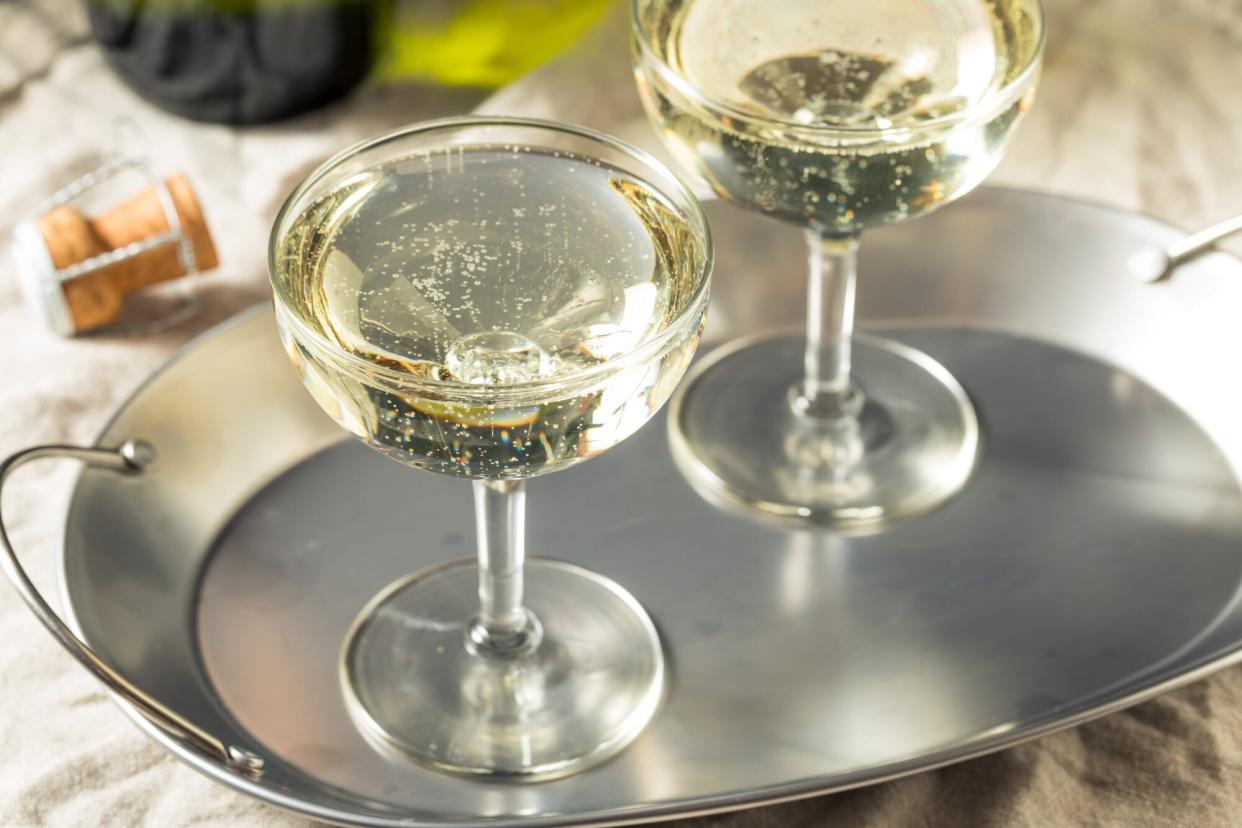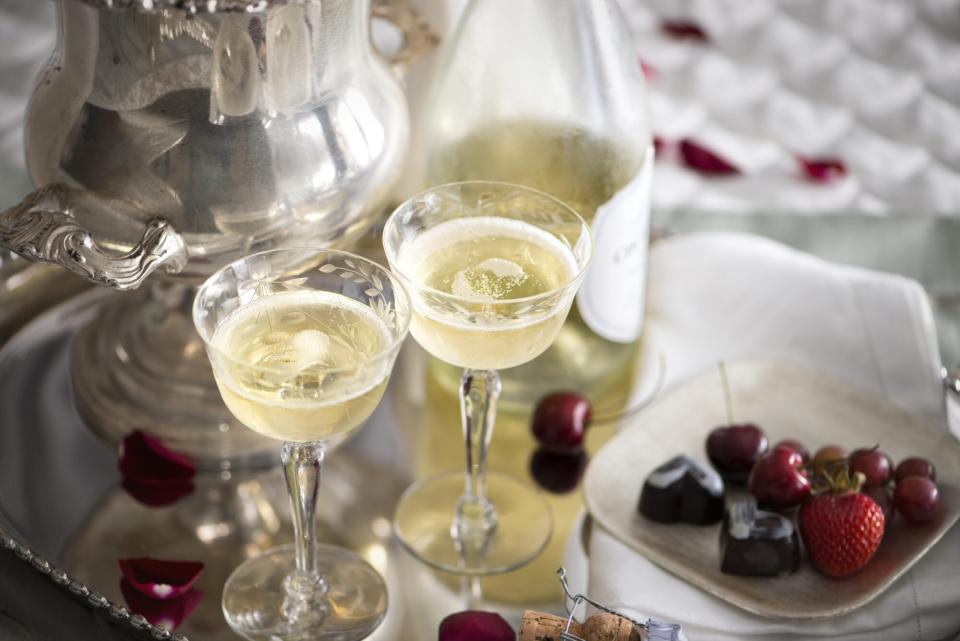The Language of Champagne: Here's What Terms Like Brut, Demi-Sec, Vintage, and Cuvée Really Mean

Getty Images
TABLE OF CONTENTS
On This Page
Brut Champagne and Dryness
Champagne Styles
Grapes and Blends
Vintage vs. Non-Vintage
Champagne Producers
Grand Cru and Premier Cru
Champagne is the wine we turn to for special occasions, birthdays, engagements, and other life landmarks—so it's not something we drink all the time. As a result, we're not as familiar with Champagne as we are with our weekend wine; it also costs significantly more than the bottles we turn to on the regular.
Bring the special language of Champagne into the mix and finding the right bottle for the celebration you're planning can be difficult. To help you select the perfect Champagne for your palate or party, we're decoding the terms that both define the wine and appear on labels, so you can choose a bottle with confidence.
Related: Why Flutes Aren't the Best Glasses for Sparkling Wine
Understanding Dryness: What Is Brut Champagne?
Champagne styles are classified by their dryness, which refers to the level of added sugar; this is also called residual sugar. There are seven different Champagne styles (more on that later!), but brut is a great place to start; it's the most popular style and on the drier (or less sweet) side. Champagne experts rate it for its versatility, especially when paired with food.
Dry Champagnes and Food
"From the apéritif to the end of the meal, a brut will shine across vegetable crudités, ceviche, fish tartare, white meat, and delicate poultry, as well as with Parmesan or a Comté cheese," says François Demouy, the communications and marketing manager at Champagne Palmer.
While brut is the top-selling style of Champagne, extra brut and brut nature, which are drier (so, less sweet), also work well with food. A classic pairing is brut nature Champagne with oysters. "They tend to show a lot of minerality, and the bubbles and acidity (of the wine) complement the texture of the oysters," says Katie Nelson, the vice president of winemaking at Chateau Ste. Michelle. Another stellar pairing is extra-brut Champagne with rich, decadent cheeses and charcuterie. "The acidity of extra-brut matches well with the fat found in meats and cheeses," says Nelson.
Sweet Champagnes and Food
If bruts are the defining style of dry Champagnes, demi sec bottles are the darlings of the sweet sparkling wine category. Though the term translates as "half dry," demi-sec Champagnes are on the sweeter side. They are preferred with desserts, rich savory dishes like foie gras, and certain cheeses. They can also create bold pairings with other dishes that are not sweet or as rich. If you're feeling adventurous, try demi sec and other sweet styles of Champagne with spicier foods, suggests Elise Cordell, a national Champagne ambassador at G.H. Mumm and Perrier-Jouët, Pernod-Ricard USA. "Demi-sec Champagnes can take on a bit more heat—think spicy barbecue, Thai, and Cajun cuisine," she says.
Champagne Styles
Beyond brut and demi-sec, you've probably heard of some other Champagne styles, such as extra dry or doux. These terms ultimately describe how dry (or sweet) the wine is. Here's what makes the terminology confusing: Extra dry is not as dry as brut—but it is drier than dry, another style of Champagne (although, one that's not so frequently seen stateside).
To better understand the language of Champagne, bookmark this handy chart, which matches sweetness with the wine's corresponding classifications; our list starts with the driest (least sweet) and ends with the sweetest:
Champagne Grapes and Blends
Only seven grape varieties can be used when making French Champagne. The main three are chardonnay, pinot noir, and pinot meunier. Four lesser-used varieties are also authorized, but not common; they include arbane, petit meslier, pinot blanc, and pinot gris.
Blanc de Blancs vs. Blanc de Noirs
Most Champagnes are made of a blend of chardonnay (white) and pinot noir (red), often with a trace of pinot meunier (red) added for a little extra aroma. But it is possible to find Champagnes made from only white or only red grapes. A Champagne made from only white grapes is called blanc de blancs and is typically all chardonnay. A Champagne made from only red grapes—typically pinot noir—is labeled blanc de noirs.
Cordell explains the flavor difference between the two:
Blanc de blancs: These wines "typically display vibrant citrus and crisp tree fruit flavors, supported by refreshing minerality and aromas of flowers," says Cordell. Perrier-Jouët's non-vintage Blanc de Blancs Brut is an embodiment of the style thanks to its freshness; it's a perfect accompaniment for salads and seafood dishes.
Blanc de noirs: These wines often have more richness than blanc de blancs, "with riper flavors reminiscent of stone fruit, honey, and pastry," says Cordell. Her pick is G.H. Mumm RSRV Blanc de Noirs, a vintage champagne from the Grand Cru village of Verzenay. "It displays candied citrus, apricots, and vanilla aromas and has a long, persistent finish with creamy bubbles," she says.
Rosé
A pink-toned Champagne is called rosé. It has a splash of red wine for added color and flavor.
Cuvée
The proprietary name given by a winemaker to a specific blend is called a cuvée.

Getty Images
Vintage vs. Non-Vintage Champagne
Non-vintage Champagne is a blend of grapes harvested across different years; these bottles will have NV on the label. A Champagne made only from grapes harvested in one specific year is called vintage. Most producers that produce vintage Champagnes only make them in exceptional years, when the weather and growing conditions are ideal, so they are rare and generally more expensive than non-vintage iterations.
Pros of Non-Vintage Champagne
Many people assume vintage Champagne will always be superior to non-vintage—but Mathieu Roland-Billecart, the CEO of Billecart-Salmon (a business that has been in his family for seven generations), shares one advantage of the latter. "NVs enable producers to keep a more consistent taste in the long run," he says.
Rather than showcasing the growing conditions of a particular year, which will always taste different, the winemaker in charge of the blend (called the cellar master) can create a "house style" that always tastes the same. You know exactly what you'll get whenever you open an non-vintage bottle.
Pros of Vintage Champagne
The special nature of vintage Champagne lies in capturing a moment in time. "Vintage Champagnes are more a 'snapshot' of the taste of a given year. Also, they are typically aged for longer and tend to provide a richer, more gastronomic taste," says Roland-Billecart.
Types of Champagne Producers
There are two main types of Champagne producers: maisons (or "houses") that buy their grapes from local farmers and then make the wines, and grower-producers who grow their grapes and make the Champagne themselves. Nearly 87 percent of the Champagnes imported into the United States come from maisons; the 24 most well-known maisons are called the Grandes Marques.
If you enjoy single-origin coffee or artisan chocolate, you may want to try grower Champagnes. They aren't necessarily better or worse than maisons in terms of quality, but they are a product of a small farmer, and you may want to support that. How do you know if you're purchasing a grower Champagne? Look for the initials "RM" on the bottle. This stands for récoltant-manipulant, which indicates the grower-producer model.
The Top Champagnes
Not all vineyards in the Champagne region are considered equal.
Grand Cru and Premier Cru
If your bottle is labeled Grand Cru, this means the wine comes from a specific vineyard within Champagne that has been designated as one of the very best by the Comité Interprofessionnel du Vin de Champagne (CIVC). The tier directly below Grand Cru is called Premier Cru.
Tête de Cuvée or Prestige Cuvée
Finally, many Champagne producers make a special bottle—one they consider is the best of what they offer. It may also have a different name than their usual maison. This is called a tête de cuvée or prestige cuvée. A good example of this is Cristal, which is the tête de cuvée of Champagne Louis Roederer; Dom Pérignon is Moët & Chandon's tête de cuvée. These are bottles you might want to seek out for a really special celebration.

